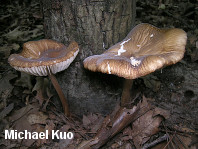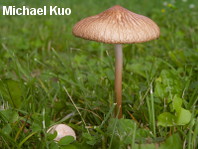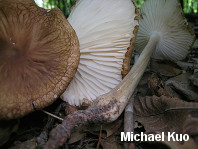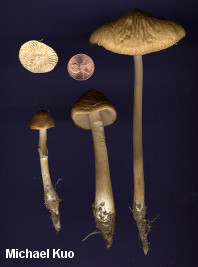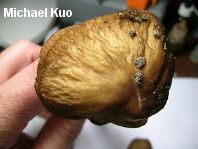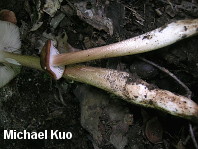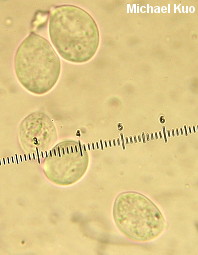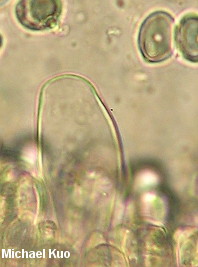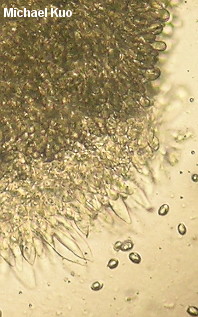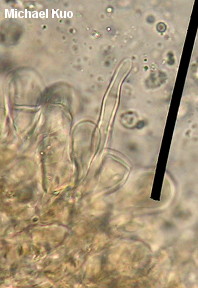| Major Groups > Gilled Mushrooms > Pale-Spored > Collybioid> > Xeruloid > Hymenopellis furfuracea |

|
Hymenopellis furfuracea [ Basidiomycota > Agaricales > Physalacriaceae > Hymenopellis . . . ] by Michael Kuo Hymenopellis furfuracea is the largest, brownest xeruloid mushroom in eastern North America, where the species pops up alone or gregariously from the buried deadwood of hardwoods. Though it usually appears to be growing "terrestrially," there is almost always a stump or dead tree nearby (in urban areas, however, the stump may have been removed). Occasionally Hymenopellis furfuracea grows directly from well-rotted wood, or around the bases of stumps. The stem of Hymenopellis furfuracea is usually brownish and finely hairy, and as the mushroom grows the brown often gets stretched out into a sort of snakeskin or chevron pattern. Most other North American xeruloid species are a bit smaller than Hymenopellis furfuracea, and many have paler (whitish to tan or dull brown) caps. However, Hymenopellis furfuracea does not always grow to capacity, and it is not infrequently a paler shade of brown than it "should be." Such specimens are best identified with microscopic examination (see the microscopic characters below, and the key to 9 xeruloid mushrooms in North America). In western North America Paraxerula americana is similar to the naked eye, but the two species do not appear to overlap in distribution. Xerula furfuracea is a synonym. Older field guides often combined Hymenopellis furfuracea with what have since been designated as separate species of Hymenopellis, in treatments of "Collybia radicata," "Oudemansiella radicata," and "Xerula radicata." Description: Ecology: Saprobic on the deadwood of hardwoods; occasionally growing directly from very well decayed logs and stumps, but more commonly attached to buried deadwood near stumps, appearing terrestrial; late spring through fall; apparently widely distributed east of the Rocky Mountains. The illustrated and described collections are from Illinois, Kentucky, and Tennessee. Cap: 1.5-12 cm; bell-shaped or occasionally convex when young, becoming broadly convex to broadly bell-shaped or nearly flat in age; bald; smooth or, more often, moderately to prominently radially wrinkled and puckered (over the center when young and later nearly overall); sticky to greasy when fresh; dark brown to grayish brown or yellow-brown, but not infrequently fading to brownish or buff; the margin incurved when young, sometimes uplifted in maturity, not lined. Gills: Broadly attached to the stem, or notched at the point of attachment, with a tiny tooth that runs down the stem; close or almost distant; white to creamy; thick; short-gills frequent. Stem: 4-16 cm long above ground; 0.5-2 cm thick; typically club-shaped when young and, later, tapering a little to apex; white and nearly bald near the apex (or, rarely, overall); brownish gray to brownish or brown and fibrillose to hairy below, with the brown areas often stretched into snakeskin or chevron patterns by maturity; with a long, tapered tap root extending up to 10 cm underground; the tap root sometimes bruising rusty brown. Flesh: Whitish; unchanging when sliced. Odor and Taste: Not distinctive. Chemical Reactions: KOH on cap surface negative. Dried Specimens: Gills of dried specimens become dingy yellowish to brownish or very pale orangish after several years in storage. Spore Print: White. Microscopic Features: Spores 12-18 x 9-12.5 µ; ellipsoid to broadly ovoid; smooth; hyaline in KOH; inamyloid. Pleurocystidia widely cylindric; hyaline; to about 125 x 40 µ. Elements on lamellar edges often collapsed and gelatinized, but when differentiated, cheilocystidia narrowly to widely fusiform, or sometimes subcylindric; up to 100 x 13 µ. Pileipellis hymeniform and somewhat gelatinized; elements subglobose-irregular to pyriform; pileocystidia frequent, thin-walled, hyaline, up to 150 x 13 µ. REFERENCES: (Peck, 1893) R. H. Petersen, 2010. (Redhead, Ginns & Shoemaker, 1987; Phillips, 1991/2005; Petersen & Methven, 1994; Barron, 1999; Roody, 2003; McNeil, 2006; Kuo & Methven, 2010; Petersen & Hughes, 2010.) Herb. Kuo 06279501, 06080302, 09300401, 08290506, 05210702, 05310706, 07051103. This website contains no information about the edibility or toxicity of mushrooms. |
© MushroomExpert.Com |
|
Cite this page as: Kuo, M. (2014, November). Hymenopellis furfuracea. Retrieved from the MushroomExpert.Com Web site: http://www.mushroomexpert.com/hymenopellis_furfuracea.html |
